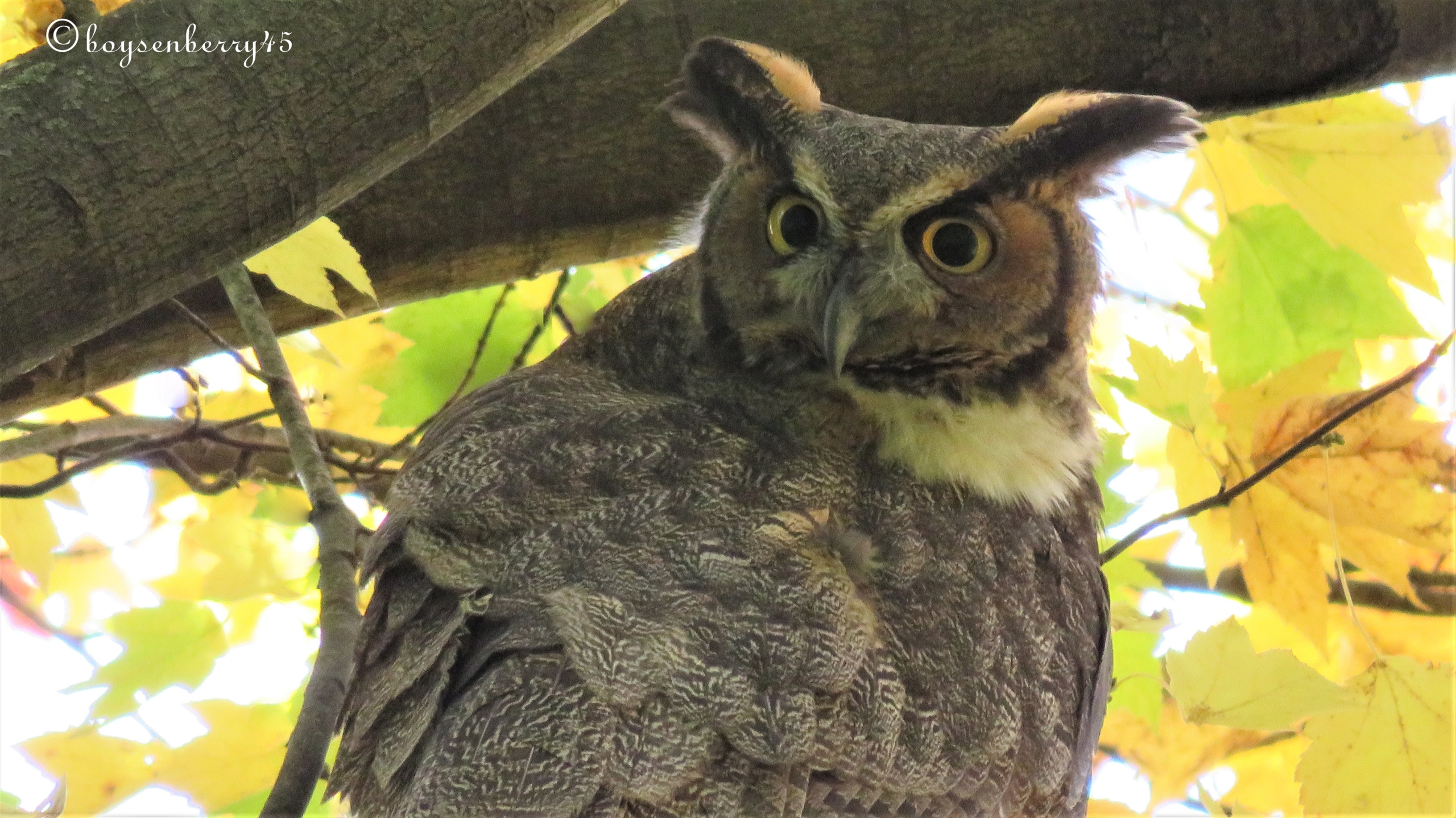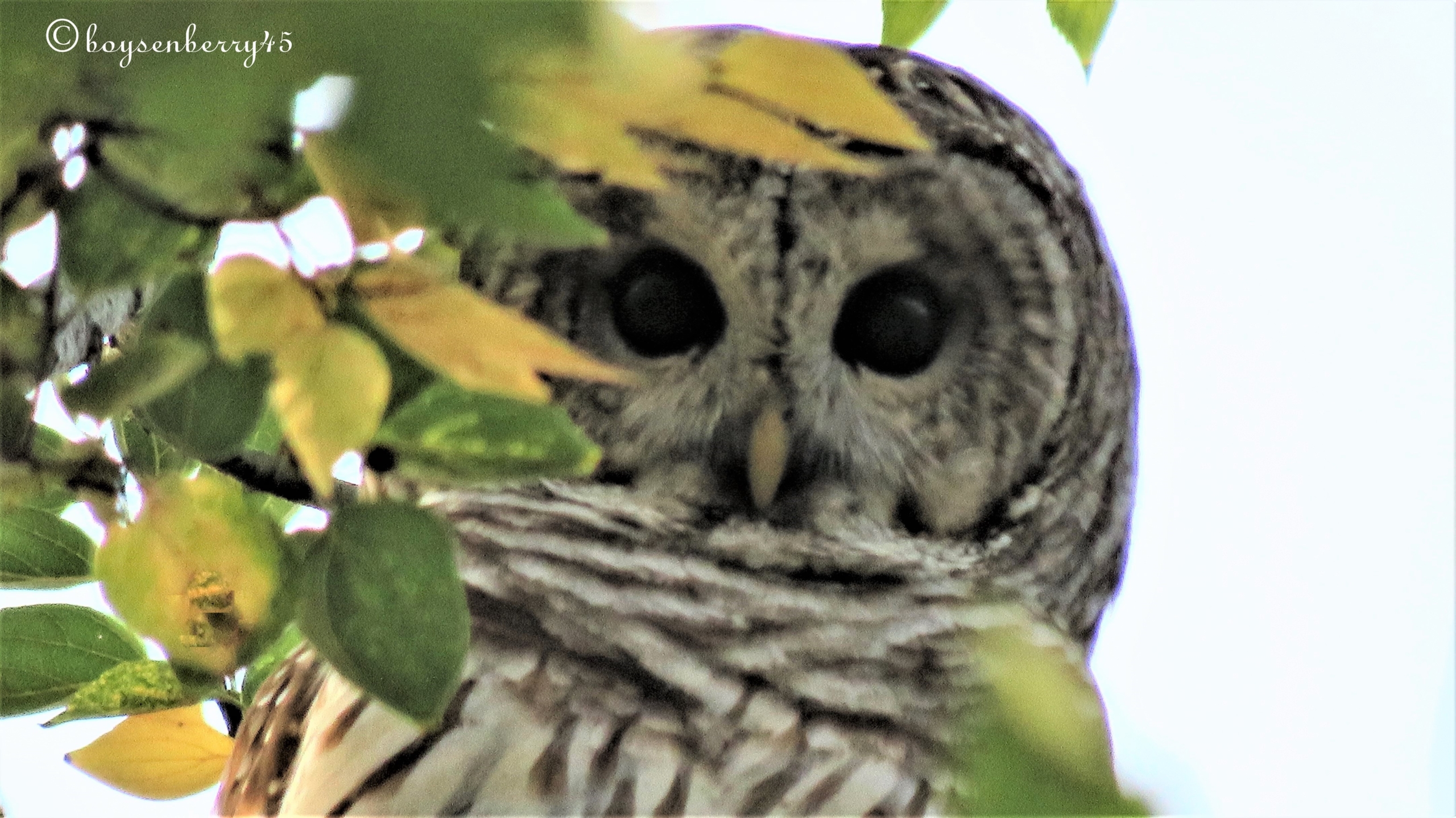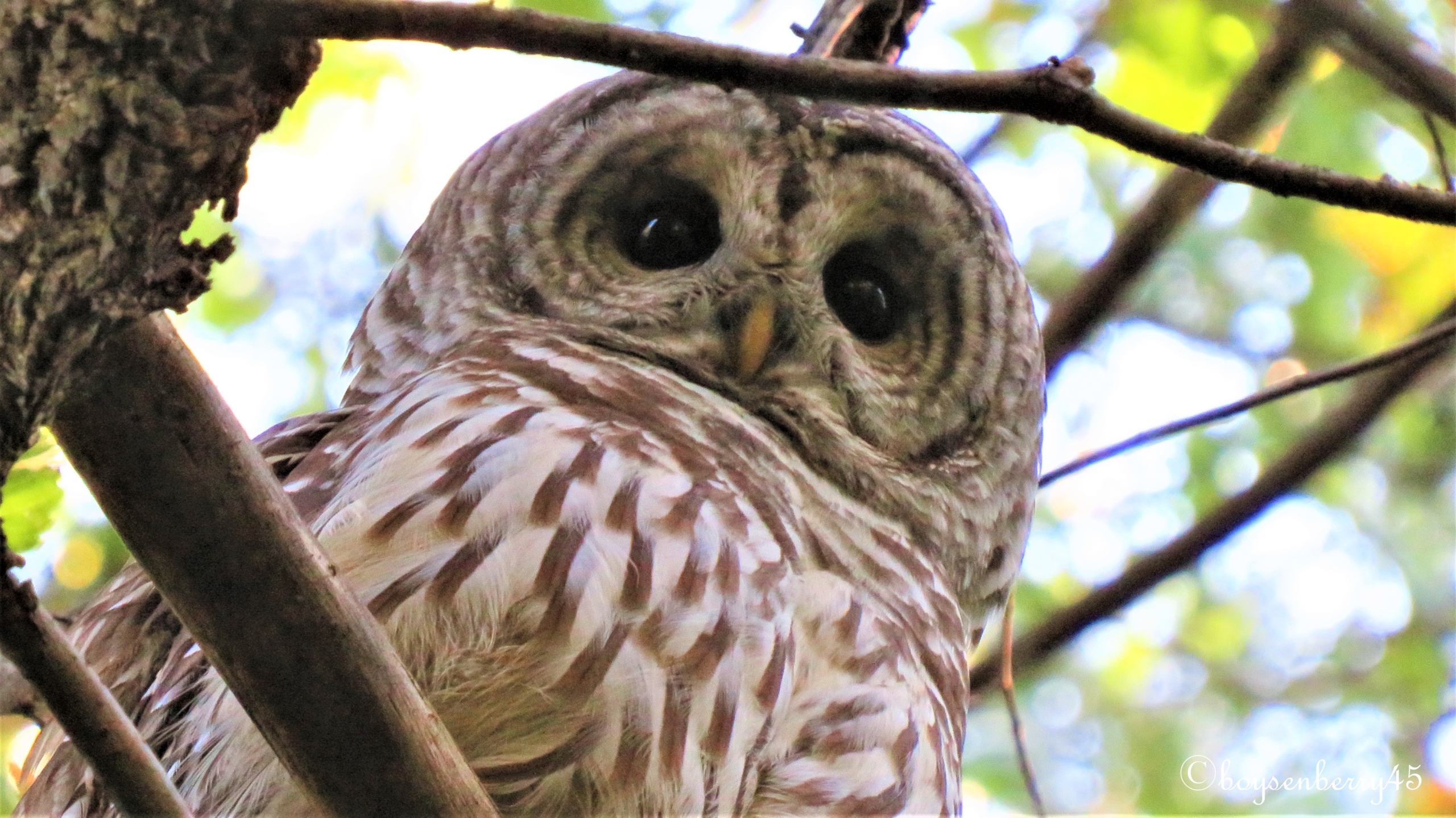
By Boysenberry45
Friday afternoon in Central Park wasn’t just magical because of the glorious fall weather. There were two different types of owls perched in the Ramble within 100 feet of each other and the lucky birders who were on hand were beyond thrilled (especially me). Central Park has been hosting a Great Horned Owl for almost one year now in the Loch in the northern end of the park. Recently, another Great Horned Owl appeared in the Ramble. (How do we know it’s a different owl? The long-time northern resident, nicknamed Geraldine, has an injured foot and the new one, still unnamed, has injury-free talons.)

A crowd was gathered near Azalea Pond in the Ramble on Friday afternoon gazing adoringly at the new Great Horned Owl framed by the lovely fall foliage when word started to spread that a Barred Owl had been briefly spotted near the feeders. After the Barred Owl flew away, a small group of birders combed the woods to locate the owl, listening carefully for the sound of blue jays and crows “mobbing” the bird to chase it away and also to warn other birds of this apex predator’s presence.
Barred Owls are no stranger to Central Park, but it has been about 15 months since the sad passing of our beloved Barry the Barred Owl, who lived in a hemlock tree in the Ramble near the Boathouse for almost one year. Barry was especially accommodating to her many daily admirers and, after she passed away, a memorial was actually held for her because she had such a fan following.

Barred Owls (aka Hoot Owls) are a relatively large North American owl species with a distinctive call that sounds like “Who cooks for you? Who cooks for you all?” They are gentle-looking, with large brown eyes in their round faces and small, bright yellow beaks. Females are larger than males, generally about 16″-20” in height and 38″–49” in wingspan. They eat mostly small mammals and are adorable in appearance and behavior (almost feline when grooming).
Great Horned Owls are slightly larger in height (17″-25”) and wingspan (48” average), but weigh almost twice as much as Barred Owls. Their “horns” are actually feather tufts known as “plumicorns”, which help give this species a somewhat fierce appearance. The GHO is a silent predator that can apply a terrifying 300 pounds per square inch of pressure on prey with their talons. Thanks to their coloration, they are also known as the Tiger Owl. Not entirely nocturnal, they mostly sleep during the day — unless disturbed by other birds or helicopters and sirens.
Great Horned Owls and Barred Owls are two very common species and must co-exist, even though the GHO is the greatest natural enemy of the Barred Owl, which is what made their proximity such a surprise on Friday. If a territorial squabble were to occur, the GHO would dominate and the Barred Owl would relocate, but the weather was so lovely that all seemed fine. That is, until the fireworks at 6:30PM on Friday above the nearby Lake to celebrate the 51st NYC Marathon, which seemed to scare off both birds. Neither owl was spotted in the Ramble on Saturday, although birders were delighted to find them both back in the Ramble on Sunday.
You can follow Boysenberry45 on Twitter and Instagram.










Beautiful,but it’s sad to consider that if they stick around it’s going to be hard to avoid the same fate as Barry.
Would that we could avoid the use of poison on rats, but given the scope of that problem, can we?
Be careful, wear a firemans hat. If they have offspring their territories are @ 3 square miles. Anybody within is fair game. Their talons if attacked is like a dog bite. Great Horned owls talons is the same pressure per square inch as a bite of a pit bull. I only want people to be safe. I found out the hard way. Keep small dogs close.
BARRED owls! Finally, no one spelled it BARN or BARD!
Cats and dogs living together!
Great article! One quick thing: Jay mobs help us find owls, but not after flyout. During nesting season loud Robin mobs help us after flyout but right now they might chirp and look annoyed but not after flyout. Our best post-flyout helpers these days are squirrels who call an alarm whine but they knock off after dusk ish. Flyout varies but it’s usually after sunset. I was part of the small group Friday & we had to stop following the Barred Owl due to the marathon fireworks which felt like Ramblegeddon. I saw bats flying away from the finale on maintenance meadow. Why, Central Park, why? xo JP
Lotsa rats. Good for predators
Interesting that this popped up on my Google feed. My wife and I were at the Met looking out the window into Central Park on October 9 when I saw what had to have been an owl and I’m assuming it was a great horned owl. Nice to see that they show up there.
Are there any free birdwatching groups/walks for beginners? Especially any that meet up around the 90s/100s?
Please don’t publish exact owl locations. Owls need to sleep during the day.
Wonderful article! We are loving all the birds, including these beautiful birds of prey, that make their home in Central Park – whether seasonally or more permanently. Unfortunately, as your top photo caption describes all the lowflying, loud helicopters that are either sightseeing/ joyriding over Central Park for “shoe selfie photos” or are commuting to the airports or Hamptons, have turned what should be a peaceful oasis into a helicopter highway. I have observed, and even filmed, hawks flying from their perches as a tourist helicopter circled overhead. This unnecessary noise and air pollution is bad for both the wildlife and the humans trying to enjoy the park. Please sign our petition at http://www.stopthechopnynj.org Thanks!
I love these bird reports. Thank you!
Linnean Society of America
Natural History Museum
Audubon Society
Birdwalks/Free